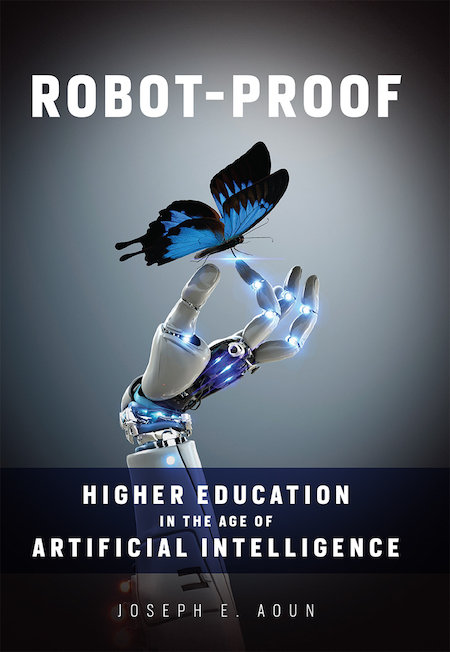The advancement of artificial intelligence means more high-skilled jobs are within the capability of smart machines. How should higher education adapt to prepare students to thrive in this new and fast-changing economy?
Northeastern University President Joseph E. Aoun explores this challenge in his new book, Robot-Proof: Higher Education in the Age of Artificial Intelligence. Below is an excerpt from the book that addresses the rise of A.I., higher education’s transformation, and the future of work.

Chapter 5
As AI, robotics, and high technology give rise to an unprecedented need for people to learn, retool, and upskill throughout their lives, higher education would do well to consider shifting its perspective in the way the railroads failed to do. Going forward, colleges and universities have the chance to recognize that they are not merely in the specific businesses of undergraduate education, graduate education, and research—although all of those remain vitally important. Rather, they are in the larger business of lifelong learning.
As a matter of fact, precisely because the higher education sector largely has yet to shift its perspective in this way, others—most notably, for-profit colleges—have stepped in to fill the breach. Between 1990 and 2010, enrollment in for-profit colleges boomed in the United States and around the world. Much of this demand came from older students and working professionals who were attracted by the flexibility of the online model used by most for- profits. In academic year 2007–2008, for example, only 11 percent of students enrolled in for-profit colleges were the “traditional” college ages of eighteen to twenty-three. And although for-profit college enrollment has since receded as some have become embroiled in scandals over allegations that they overstated their graduates’ job placement rates, the overall trend clearly shows that the appetite for lifelong learning in the market is strong.
It is not only for-profits that have taken up the banner of lifelong learning. There also has been an upsurge in “corporate universities,” or in-house academies for training managers. General Electric is credited with pioneering the approach in the 1950s, and the model has exploded in recent decades. Boston Consulting Group estimates that their number doubled between 1997 and 2007, recently reaching about five thousand corporate universities world- wide. As a corollary to this model, some companies are partnering with nontraditional providers to offer further education to their employees. For example, AT&T is working with MOOC (massive open online course) provider Udacity to offer its employees the chance to upskill—and giving them negative performance reviews if they choose not to invest their own time in taking courses.
The “corporate university” model has many appealing facets. It allows companies to tailor employees’ learning to their particular business needs. It also can serve as a pipeline for training managers within the firm’s culture. At the same time, it fails to account for one of Warren Buffett’s basic investment tenets: stick to what you know. Very few enterprises besides colleges and universities are in the business of higher education. Thus, when companies set up in-house education programs, they are not playing to their strengths.
The rise of in-house corporate education is further evidence that higher education is sidelining lifelong learning to its detriment. Education is what colleges and universities do best, so companies should not have to take up the academic mantle. It makes better business sense to partner with the experts. If my university is interested in selling clothing in our school colors, instead of building our own garment factory, we outsource the job to an established clothing manufacturer. The very fact that for-profits and corporate universities have seen such growth shows that higher education is failing to serve its natural constituencies.
This missed opportunity is especially unfortunate because today’s professionals are facing challenges as profound as those faced by the workers of Pitman’s and Darwin’s day. Just like them, they are immersed in rapidly changing work environments to which they must adapt or risk losing their competitiveness. Just like them, the escalation of technology means that they must increase their uniquely human skills through further education. And just like them, in an increasingly complex economy, lifelong learning may well be the difference between their professional evolution and their economic extinction. In this context, the old Field of Dreams approach no longer suffices: universities cannot simply build monolithic programs and expect lifelong learners to show up. Instead, effective programs will have to be customized and personalized for the growing cadre of lifelong learners.